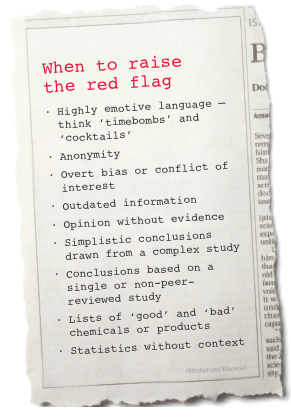We are surrounded by media – whether it be traditional print, online sources including websites and blogs, product packaging, film, television or radio.
Do you believe everything you read? Or hear? Or see? Of course not. As a unique individual, you bring an individual set of values to every media text you encounter, which helps determine whether you accept a message at face value, reject it completely, or engage in further negotiation to determine whether you will accept or reject it.
The formulated chemical products industry – think cleaning, hygiene, cosmetics and personal care – faces some texts that perpetuate misinformation about our industry. Most relate to concerns with the safety of everyday products and ingredients via claims that are not upheld by scientific evidence.
It is important to be able to critically evaluate the texts we encounter every day. This is because media texts are not neutral and natural, they are value-embedded constructs of reality: a product of authors making choices and manipulating creative tools to target a particular audience. And they have a particular purpose – often to sell a product, service or ideology. Key questions need to be asked: Who constructed this? For what purpose? What are the author’s credentials? What values and points of views are represented, or omitted? Are they providing opinion or fact? Are they qualified to provide this information? Could they be misinformed or misunderstand an issue? Do they back up claims and can information be verified via other reliable sources? And – ultimately – should I take action as a result?
Lipstick is often in the firing line. ‘Chemicals in lipstick and cleaning products linked to early menopause’ was an early 2015 headline in The Australian. ‘Poisonous puckers’ did the rounds in the US a couple of years ago. Search for ‘lead in lipstick’ and your browser will return many pages listing lipsticks by their lead levels or identifying lead-free lipsticks (‘safe, non-toxic make-up’) – this is despite regulators in Australia, the European Union, the US, and Canada agreeing that the levels of lead in lipstick pose no risk.
When texts like these are amplified via online news sources, blogs and websites, they can generate unwarranted alarm in the community. Another example, covered in the July 2014 issue of Chemistry in Australia (p. 35), is where sunscreen ‘nanophobia’ was resulting in some Australians not using sunscreen because of unfounded safety fears.
To combat unfounded fears about chemicals and everyday chemical products, Accord developed the www.furphies.org.au website. As well as providing information on some of the more persistent myths, Furphies also provides guidance on critical evaluation of media on chemical-related issues: how to work out if an issue is worth your concern, or is simply a ‘beat-up’.
For example, Furphies cautions people to be wary of:
- phrases such as ‘associated with’ or ‘linked to’; these do not mean that a causal connection has been established
- the phrase ‘found in’; just because a substance is present, whether in a product or in the human body, doesn’t mean that it has an adverse effect – any substance can be harmful in certain quantities, or in the wrong place, or if used in the wrong way
- comparisons of humans and animals; animal studies where high doses of a substance cause adverse effects do not necessarily mean that humans will show similar adverse effects when metabolising very low doses of the same substance.
Be especially wary of online media. Anyone can post information or broadcast their opinion – but how can we know that what we are reading is accurate and unbiased, or even current? For example, Wikipedia is written and edited by anonymous authors, making it ‘the source where you can be an authority even if you don’t know what the hell you’re talking about’ (Steve Colbert, referred to at www.bit.ly/1Ll9qKR).
Of course, Furphies itself is not agenda-free. The goal of Furphies is to erode misconceptions about chemicals and everyday chemical products through careful presentation of evidence and by encouraging critical evaluation of media. It aims to promote more balanced thinking when encountering media texts and avoid undue public alarm.
Please check it out and spread the word!



